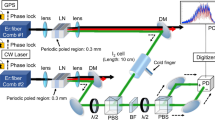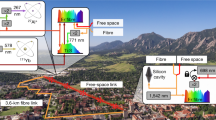Abstract
Laser frequency combs (LFCs) are well on their way to becoming the next-generation calibration sources for precision astronomical spectroscopy1,2,3,4,5,6. This development is considered key in the hunt for low-mass rocky exoplanets around solar-type stars whose discovery with the radial-velocity method requires cm s–1 Doppler precision7. In order to prove such precise calibration with an LFC, it must be compared to another calibrator of at least the same precision. Being the best available spectrograph calibrator, this means comparing it to a second—fully independent—LFC. Here, we report on a test in which two separate LFCs were used to simultaneously calibrate an astronomical spectrograph. Our installation of two LFCs at the ultra-stable two-channel spectrograph HARPS allowed characterization of their relative stability and consistency in calibration at the highest available level. Although the test was limited in time, the results confirm the 1 cm s–1 stability that has long been anticipated by the astronomical community.
This is a preview of subscription content, access via your institution
Access options
Access Nature and 54 other Nature Portfolio journals
Get Nature+, our best-value online-access subscription
$29.99 / 30 days
cancel any time
Subscribe to this journal
Receive 12 digital issues and online access to articles
$119.00 per year
only $9.92 per issue
Buy this article
- Purchase on Springer Link
- Instant access to full article PDF
Prices may be subject to local taxes which are calculated during checkout





Similar content being viewed by others
Data availability
The data that support the plots within this paper and other findings of this study are available from the corresponding author upon reasonable request. The HARPS data are publicly available from http://archive.eso.org/wdb/wdb/eso/repro/form and https://www.eso.org/sci/activities/instcomm/harps_lfc.html. LFC2/LFC2 series: 2015-04-17, 14:40:26–16:14:46 utc, LFC2/LFC1 series: 2015-04-17, 18:26:12–20:06:36 utc.
References
Glenday, A. G. et al. Operation of a broadband visible-wavelength astro-comb with a high-resolution astrophysical spectrograph. Optica 2, 250–254 (2015).
Wilken, T. et al. A spectrograph for exoplanet observations calibrated at the centimetre-per-second level. Nature 485, 611–614 (2012).
Molaro, P. et al. A frequency comb calibrated solar atlas. Astron. Astrophys. 560, A61 (2013).
Yi, X. et al. Demonstration of a near-IR line-referenced electro-optical laser frequency comb for precision radial velocity measurements in astronomy. Nat. Commun. 7, 10436 (2016).
Löhner-Böttcher, J. et al. LARS: an Absolute Reference Spectrograph for solar observations. Astron. Astrophys. 607, A12 (2017).
Obrzud, E. et al. A microphotonic astrocomb. Nat. Photon. 13, 31–36 (2019).
Fischer, D. A. et al. State of the field: extreme precision radial velocities. Publ. Astron. Soc. Pac. 128, 66001 (2016).
Udem, T., Holzwarth, R. & Hänsch, T. W. Optical frequency metrology. Nature 416, 233–237 (2002).
Murphy, M. T. et al. High-precision wavelength calibration of astronomical spectrographs with laser frequency combs. Mon. Not. R. Astron. Soc. 380, 839–847 (2007).
McCracken, R. A. et al. Wavelength calibration of a high resolution spectrograph with a partially stabilized 15-GHz astrocomb from 550 to 890 nm. Opt. Express 25, 6450–6460 (2017).
Ycas, G. G. et al. Demonstration of on-sky calibration of astronomical spectra using a 25 GHz near-IR laser frequency comb. Opt. Express 20, 6631–6643 (2012).
Steinmetz, T. et al. Laser frequency combs for astronomical observations. Science 321, 1335–1337 (2008).
Probst, R. A. et al. A laser frequency comb featuring sub-cm/s precision for routine operation on HARPS. Proc. SPIE 9147, 91471C (2014).
McCracken, R. A., Charsley, J. M. & Reid, D. T. A decade of astrocombs: recent advances in frequency combs for astronomy. Opt. Express 25, 15058–15078 (2017).
Suh, M. et al. Searching for exoplanets using a microresonator astrocomb. Nat. Photon. 13, 25–30 (2019).
Kerber, F., Nave, G. & Sansonetti, C. J. The spectrum of Th-Ar hollow cathode lamps in the 691–5804 nm region: establishing wavelength standards for the calibration of infrared spectrographs. Astrophys. J. Suppl. Ser. 178, 374–381 (2008).
Lovis, C. & Pepe, F. A new list of thorium and argon spectral lines in the visible. Astron. Astrophys. 468, 1115–1121 (2007).
Nave, G. et al. The dirt in astronomy’s genie lamp: ThO contamination of Th-Ar calibration lamps. Proc. SPIE 10704, 1070407 (2018).
Mayor, M. & Queloz, D. A Jupiter-mass companion to a solar-type star. Nature 378, 355–359 (1995).
Anglada-Escudé, G. et al. A terrestrial planet candidate in a temperate orbit around Proxima Centauri. Nature 536, 437–440 (2016).
Astudillo-Defru, N. et al. The HARPS search for southern extra-solar planets XLII. A system of Earth-mass planets around the nearby M dwarf YZ Ceti. Astron. Astrophys. 605, L11 (2017).
Pepe, F. et al. The HARPS search for Earth-like planets in the habitable zone I. Very low-mass planets around HD 20794, HD 85512, and HD 192310. Astron. Astrophys. 534, A58 (2011).
Pepe, F., Ehrenreich, D. & Meyer, M. R. Instrumentation for the detection and characterization of exoplanets. Nature 513, 358–366 (2014).
Liske, J. et al. Cosmic dynamics in the era of Extremely Large Telescopes. Mon. Not. R. Astron. Soc. 386, 1192–1218 (2008).
Ravi, A. et al. Probing dark matter using precision measurements of stellar accelerations. Phys. Rev. Lett. 123, 091101 (2019).
Webb, J. K. et al. Indications of a spatial variation of the fine structure constant. Phys. Rev. Lett. 107, 191101 (2011).
Mayor, M. et al. Setting new standards with HARPS. Messenger 114, 20–24 (2003).
Brucalassi, A. et al. Stability of the FOCES spectrograph using an astro-frequency comb as calibrator. Proc. SPIE 9908, 99085W (2016).
Hao, Z. et al. Calibration tests of a 25-GHz mode-spacing broadband astro-comb on the fiber-fed High Resolution Spectrograph (HRS) of the Chinese 2.16-m telescope. Publ. Astron. Soc. Pac. 130, 125001 (2018).
Probst, R. A. et al. Relative stability of two laser frequency combs for routine operation on HARPS and FOCES. Proc. SPIE 9908, 990864 (2016).
Wilken, T. et al. High-precision calibration of spectrographs. Mon. Not. R. Astron. Soc. 405, L16–L20 (2010).
Pfeiffer, M. J., Frank, C., Baumüller, D., Fuhrmann, K. & Gehren, T. FOCES—a fibre optics Cassegrain échelle spectrograph. Astron. Astrophys. Suppl. Ser. 130, 381–393 (1998).
Probst, R. A. et al. Spectrally flattened, broadband astronomical frequency combs. In CLEO 2015 SW4G.7 (Optical Society of America, 2015).
Probst, R. A. et al. Spectral flattening of supercontinua with a spatial light modulator. Proc. SPIE 8864, 88641Z (2013).
Mahadevan, S., Halverson, S., Ramsey, L. & Venditti, N. Suppression of fiber modal noise induced radial velocity errors for bright emission-line calibration sources. Astrophys. J. 786, 18 (2014).
Hunter, T. R. & Ramsey, L. W. Scrambling properties of optical fibers and the performance of a double scrambler. Publ. Astron. Soc. Pac. 104, 1244–1251 (1992).
HORIZONS Web-Interface https://ssd.jpl.nasa.gov/horizons.cgi (Jet Propulsion Laboratory, California Institute of Technology, NASA).
Lanza, A. F., Molaro, P., Monaco, L. & Haywood, R. D. Long-term radial-velocity variations of the Sun as a star: the HARPS view. Astron. Astrophys. 587, A103 (2016).
Dumusque, X. et al. HARPS-N observes the Sun as a star. Astrophys. J. Lett. 814, L21 (2015).
Probst, R. A. et al. Nonlinear amplification of side-modes in frequency combs. Opt. Express 21, 11670–11687 (2013).
Horne, K. An optimal extraction algorithm for CCD spectroscopy. Publ. Astron. Soc. Pac. 98, 609–617 (1986).
Acknowledgements
We cordially thank the technical staff of the La Silla Observatory for their assistance during the installation and the test run. We are equally grateful to P. St. J. Russell and his group from the Max Planck Institute for the Science of Light for their support on the development of tapered photonic crystal fibres to broaden the LFC spectrum. B.L.C.M., I.d.C.L. and J.R.d.M. acknowledge CNPq, CAPES and FAPERN Brazilian agencies.
Author information
Authors and Affiliations
Contributions
R.H., F.G., L.P., G.L.C., J.R.d.M., R.R. and M.E. initiated the project. G.L.C., T.S., H.K., G.A., Y.W., A.S.M., F.K., R.A.P., A.M., B.L.C.M., I.d.C.L., L.P., O.M., E.P., J.R.d.M., R.H. and J.U. were at the La Silla Observatory for on-site activities during the campaign. T.S., Y.W., H.K., A.B. and F.G. provided and operated the LFCs. O.M., E.P. and J.U. programmed the software to integrate the LFCs into the infrastructure of the observatory. G.L.C., B.L.C.M. and F.K. operated the spectrograph. A.M. and G.A. designed, built and optimized the light injection and scrambling in multimode fibres. R.A.P., D.M., G.L.C., A.S.M. and I.d.C.L. analysed the LFC data. B.T.-P. and J.I.G.H. analysed the Ceres observation. R.H., Th.U., T.W.H., L.P., R.R. and J.R.d.M. supervised the work. R.A.P. wrote the manuscript. All authors discussed and commented on the manuscript.
Corresponding author
Ethics declarations
Competing interests
The authors declare no competing interests.
Additional information
Peer review information Nature Astronomy thanks Richard McCracken, David F. Phillips and the other, anonymous, reviewer(s) for their contribution to the peer review of this work.
Publisher’s note Springer Nature remains neutral with regard to jurisdictional claims in published maps and institutional affiliations.
Supplementary information
Supplementary Information
Supplementary discussion, Figs. 1–8 and references.
Rights and permissions
About this article
Cite this article
Probst, R.A., Milaković, D., Toledo-Padrón, B. et al. A crucial test for astronomical spectrograph calibration with frequency combs. Nat Astron 4, 603–608 (2020). https://doi.org/10.1038/s41550-020-1010-x
Received:
Accepted:
Published:
Issue Date:
DOI: https://doi.org/10.1038/s41550-020-1010-x



